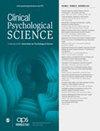Integrating “Lumpers” Versus “Splitters” Perspectives: Toward a Hierarchical Dimensional Taxonomy of Eating Disorders From Clinician Ratings
IF 4.1
2区 医学
Q1 PSYCHIATRY
引用次数: 0
Abstract
In this study, we describe a hierarchical dimensional model of eating-disorder (ED) classification based on the Hierarchical Taxonomy of Psychopathology. Participants were community-recruited adults with an ED ( N = 252; 81.9% female). We used a modified version of Goldberg’s method, which involved sequentially extracting latent factors using exploratory structural equation modeling, resulting in a 10-factor hierarchical-dimensional model. Dimensions predicted 92.4% and 58.7% of the variance in recovery outcomes at 6 months and 1 year, respectively. Compared with other illness indicators (e.g., Diagnostic and Statistical Manual of Mental Disorders [ DSM] diagnoses, dimensional ED impairment scores, weight/shape overvaluation, and DSM ED-severity specifiers), hierarchical dimensions predicted 0.88 to 334 times more variance in ED behaviors at baseline and 1.95 to 80.8 times more variance in psychiatric impairment at 1-year follow-up. Results suggest that reducing within-disorder heterogeneity for EDs within the broader context of internalizing symptoms provides a powerful framework from which to predict outcomes and understand symptoms experienced by people with EDs.整合“块状”与“分裂”的观点:从临床医生的评级走向饮食失调的层次维度分类
在本研究中,我们描述了一个基于精神病理学层次分类法的进食障碍(ED)分类的层次维度模型。参与者是社区招募的患有ED的成年人(N = 252;81.9%的女性)。我们使用了Goldberg方法的改进版本,该方法涉及使用探索性结构方程建模顺序提取潜在因素,从而得到一个10因素的层次维度模型。维度分别预测了6个月和1年恢复结果方差的92.4%和58.7%。与其他疾病指标(如精神障碍诊断与统计手册[DSM]诊断、ED障碍维度评分、体重/体型高估和DSM ED严重程度指标)相比,分层维度预测ED行为基线方差为0.88 - 334倍,1年随访时精神障碍方差为1.95 - 80.8倍。结果表明,在内化症状的更广泛背景下减少急症的障碍内异质性为预测结果和理解急症患者所经历的症状提供了一个强大的框架。
本文章由计算机程序翻译,如有差异,请以英文原文为准。
求助全文
约1分钟内获得全文
求助全文
来源期刊

Clinical Psychological Science
Psychology-Clinical Psychology
CiteScore
9.70
自引率
2.10%
发文量
35
期刊介绍:
The Association for Psychological Science’s journal, Clinical Psychological Science, emerges from this confluence to provide readers with the best, most innovative research in clinical psychological science, giving researchers of all stripes a home for their work and a place in which to communicate with a broad audience of both clinical and other scientists.
 求助内容:
求助内容: 应助结果提醒方式:
应助结果提醒方式:


